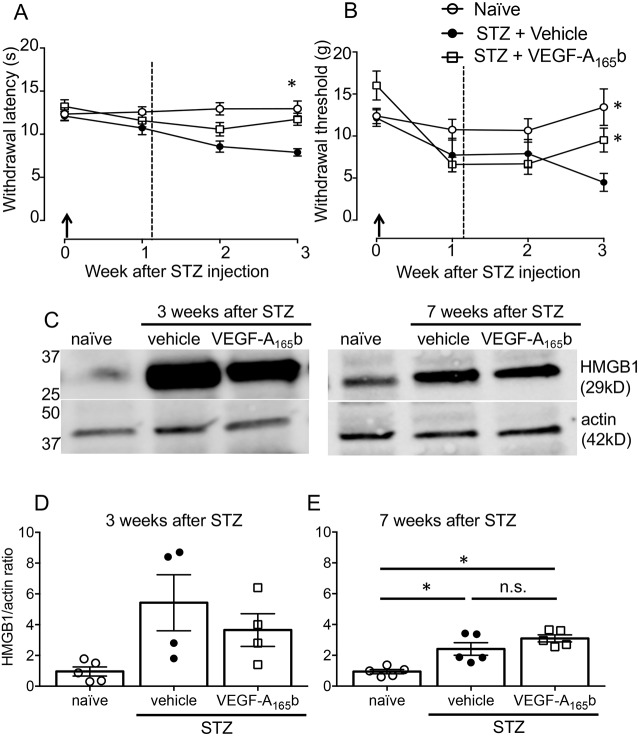Fig. 1.
Effect of VEGF-A165b on thermal and mechanical hypersensitivity in rats with STZ-induced diabetes. (A) STZ-induced thermal hypersensitivity was evident at 3 weeks after STZ injection, and was prevented with systemic VEGF-A165b [two-way ANOVA, treatment: F(2103)=17.26, P=<0.0001; time: F(3103)=3.74, P=0.013; interaction: F(6103)=2.59, P=0.022. *P<0.05 post-hoc Sidak's test]. (B) STZ-induced mechanical hypersensitivity, measured by a reduction in 50% withdrawal thresholds, was prevented with VEGF-A165b by week 3 [two-way ANOVA, treatment: F(2104)=6.744, P=0.0018; time: F(3104)=8.337, P<0.0001; interaction: F(6104)=3.03, P=0.009. *P<0.05, post-hoc Sidak's test]. Arrows indicate STZ injection and the dotted line the start of twice weekly systemic rhVEGF-A165b or vehicle treatment. Data shown are mean±s.e.m. (naïve, n=11; STZ+PBS, n=9; STZ+VEGF-A165b, n=9). (C) Representative western blots of HMGB1 and actin in hind paw plantar skin at 3 and 7 weeks after STZ injection. (D) HMGB1 protein expression was increased in skin from diabetic rats at both 3 (Kruskal–Wallis statistic 7.367, P=0.0132) and (E) 7 weeks [one-way ANOVA F(2,12) =15.31, P=0.0005]. The change in HMGB1 was not altered with VEGF-A165b treatment. Plots show mean±s.e.m. and individual data points [n=5 (naïve at both 3 and 7 weeks, STZ 7 weeks), n=4 (STZ, 3 weeks). *P<0.05, n.s., not significant, post-hoc Dunn's (3 weeks) and Sidak's tests (7 weeks)].

